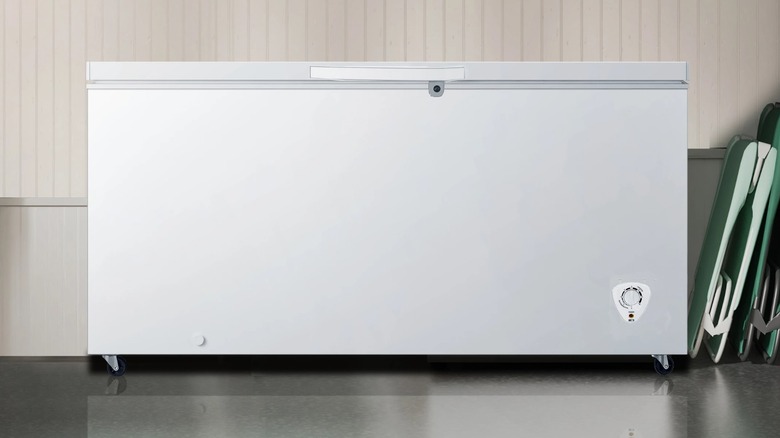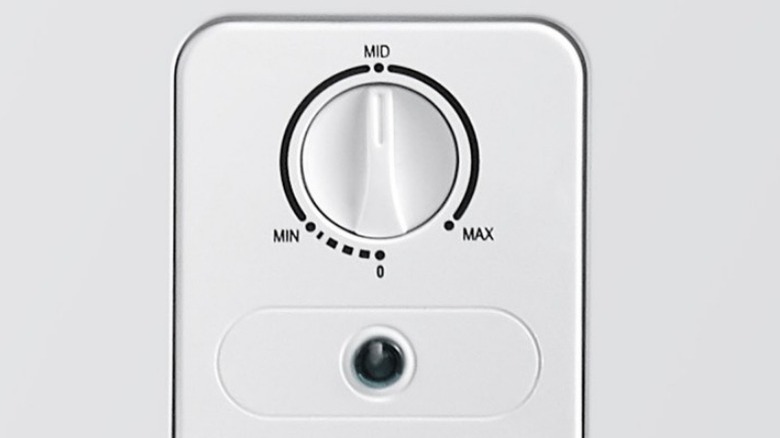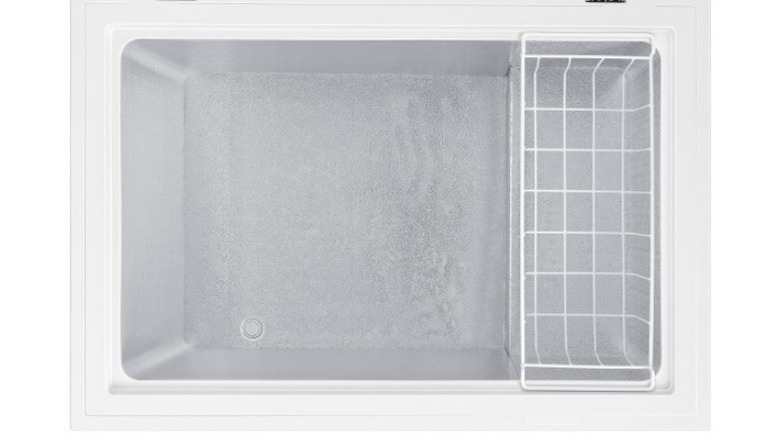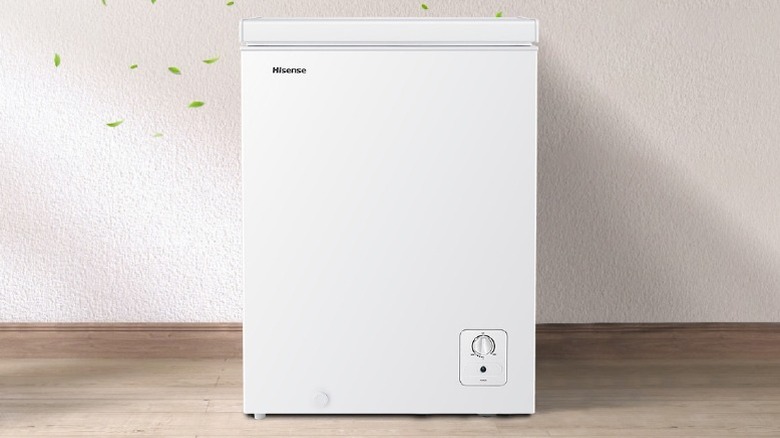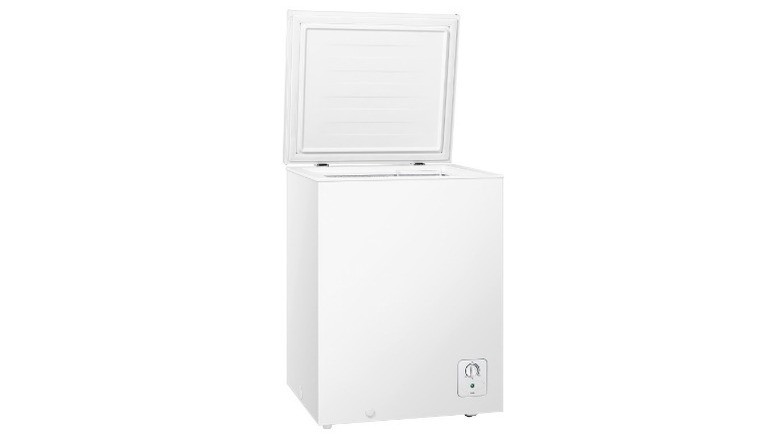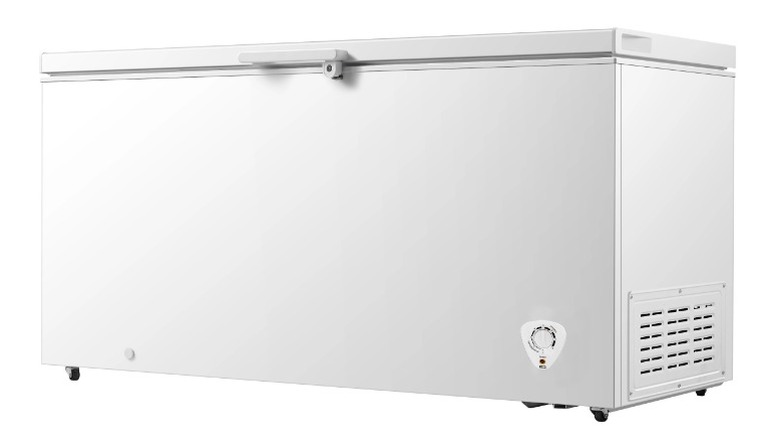Why Your Hisense Chest Freezer May Not Be Working (And How To Possibly Fix It)
It's always a pain when a fridge or freezer stops working. Not only do you have a faulty appliance to deal with, but you also have the ticking clock of perishable foods that you want to keep from going bad as the icebox's internal temperature slowly starts to climb. This can happen to even the biggest major refrigeration brands. In these situations, it might be best for you to see if there's anything you can do yourself to get the device up and running again before contacting a service professional. That way, you can get the machine up and running right away and avoid having to throw away spoiled food.
The Chinese brand Hisense makes several refrigeration products, including three chest freezers: a 5.0 cu. ft. model, a 7.0 cu. ft. model, and a large 17.7 cu. ft. model. These refrigerators and freezers are generally well-regarded by owners, but even they can occasionally stop working. Several users who own one of these have reported an issue where the freezer will suddenly stop producing cold air. Fortunately, Hisense has provided a list of likely culprits for the issue and instructions for things that you can do to try and fix them before biting the bullet and taking it in for repair or replacement.
That said, the two smaller freezers come with a one-year warranty for parts and repair, and the larger freezer comes with a two-year warranty. You may wish to take advantage of these before taking on any invasive repairs that may void them.
Make sure the freezer is properly set up
The first step in troubleshooting a warm freezer is to make sure that it's set up properly. It could be that the appliance is actually working exactly as intended and that it simply needs a slight adjustment in its settings.
Hisense recommends that you start by making sure that it's plugged in. Freezers might get bumped or moved, and it's all too easy for a plug to get pulled from a loose socket. The company also recommends making sure that the interior isn't packed too tightly, as this can prevent the cold air that is being vented in from the outer walls from being able to reach the center, allowing the food there to remain warm.
It's also worth checking to make sure that the freezer is set to the correct temperature. All three of the Hisense chest freezer models have a dial on the front of the unit that allows you to adjust the internal temperature. This can easily be bumped or accidentally turned by a small child, leading to the temperature rising inside the unit. These dials offer a wide range of temperature control. The 5.0 and 7.0 cu. ft. models can be set anywhere from -9.4 to 8.6°F, and the 17.7 cu. ft. model can be set anywhere from -13°F to 50°F. That said, Hisense states the ideal temperature that its freezers should operate at is -18°C (-0.4°F). The dials don't have specific temperatures on them and simply say Min, Mid, and Max, however, so you may need a separate thermometer to verify that your freezer is operating at the correct temperature.
Check the compressor
The next thing that you'll want to check is the compressor. This is usually located at the bottom of the freezer near the back. Listen closely to see if it's making any noise. Hisense states that the compressor should make "a quiet whirring noise, almost like a mini air conditioner" when it is functioning properly. "If the noises are prolonged or overly loud, that could be a problem requiring further investigation."
Hisense doesn't offer any further advice on this problem, but Family Handyman spoke to their appliance consultant, Costas Stavrou, who claimed that there are a few things you can try. The first thing is to unplug the freezer and pull it away from the wall for around 20 minutes in order to give the compressor a chance to cool down. Once that's done, plug it back in and see if the sound returns.
If it does, those who are comfortable opening up the back panel of the freezer can try purchasing either an overload and a compressor relay or a universal relay kit and installing it. This is a $30 solution that can fix a bad relay, but not a blown compressor. If the noise still returns, then the compressor is likely blown and the fridge will either require expensive service or a complete replacement. Those who own the 17.7 cu ft. model have a longer, five-year warranty on parts for the sealed system, including the compressor, unless the unit is deemed to have been used in a harsh environment, in which case the warranty only lasts one year.
Check that the door is fully sealed
Another potential fail point to consider is the lid. Like nearly all modern refrigerators, the Hisense chest freezers use doors that have gasket seals around the edges to prevent air from moving in and out of the icebox. This helps keep the cold air in and the warm air out. It isn't completely foolproof, though. Overfilling the ice chest can prevent the lid from closing, thus allowing the cold to escape and letting the inside of the chest get warm. Large and awkwardly shaped items that don't quite fit in the chest can also prevent the lid from closing properly.
You'll also want to check the integrity of the gasket seal lining the door to make sure it's intact. Rips and tears in the material can also be a breach in the seal that can prevent your unit from staying airtight. These can't really be repaired once they're damaged, but replacing them is easy and affordable. There are self-proclaimed universal kits that you can buy from third-party manufacturers, but Hisense sells replacement gaskets that you can purchase on its website that are specifically made to fit its freezers. The seal for the 5.0 cu. ft. model, for instance, is available for just $10.95.
Reset the unit switch
Once you've checked these other potential issues, it's time to try a hard reset. "Reset the unit by switching it off from the power switch and waiting five minutes before turning it back on," says Hisense. "It may take up to four hours to reach an optimal temperature. The larger the unit, the longer it will take." So those who have the 5.0 cu. ft. model should expect the freezer to get cold significantly faster than those who have the 17.7 cu. ft. one.
You may have already done this if you noticed an issue with the compressor, but it's worth trying even if the compressor sounds normal. This is because the compressor isn't the only component in the freezer that can benefit from being reset. According to Stavrou, a prolonged period without power will also reset any onboard computer-powered components inside the appliance. Like all computers, these components can accumulate bugs and errors if left running for an extended period of time. Giving them a chance to reset may clear the issue without you needing to resort to more drastic repairs.
Check ventilation
The last thing that Hisense recommends is that you check out the ventilation panel on the back or side of the freezer. There should be several ports that allow the freezer's motor to vent the heat that it generates during operation. You'll want to check these to make sure that they are unobstructed and that they aren't blocked by dust, lint, or any other form of debris.
Hisense recommends that you clean out any dust from the rear of the unit and that you consult the user guide for full maintenance instructions. This manual recommends that you clean the exterior of the freezer with a soft, dry cloth. It states that if the area is really dirty, you can use a cloth that has been moistened with detergent, followed by another cloth that has been dipped in clean water. It also warns that you should "never use polishing powder, soap powder, benzine, oil, or hot water, as these will damage the painting and plastic components."
